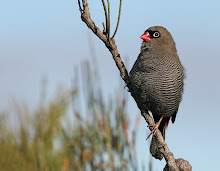Just returned from a wonderful 3 day camp with the Hunter Bird Observers Club in the grassy woodlands west of Manilla, NSW. Borah Travelling Stock Route is a magic spot made up of mostly remnant box woodland, a beautiful little creek and some large, open grassy areas. 30+ members attended the camp and a great time was had.

Red-winged Parrot, Jacky Winter, Restless Flycatcher, White-backed Swallow, Apostlebird, Grey-crowned Babbler, White-bellied Cuckoo-shrike and Spiny-cheeked Honeyeater were ticked off several kilometres before the campsite.After setting up camp we decided to make the most of the time available and headed off in search of the woodland specialists. We easily found Azure Kingfisher, Double-barred Finch, Buff-rumped Thornbill, Speckled Warbler and Fuscous Honeyeater. Dia

mond Firetails called from high, exposed branches making photos impossible. Several Brown Treecreepers were very vocal up towards the main road and a White-throated Gerygone gave a great show.
That night Southern Boobook and Owlet-nightjar called non stop.
The next morning we were up and about early and were rewarded with a pair of Hooded Robins hunting over their patch. Little and Musk Lorikeets screeched overhead as King and Red-winged Parrots drifted through the trees. Dusky Woodswallows were quite common and a young one was found. A highlight was seeing 10 White-backed Swallows perched in a dead tree. I finally managed half decent shots of Black-chinned Honeyeater which was exciting but not as good as the female Turquoise Parrot pics 6 of us scored as she fed quitely in a low shrub. Crested Shrike-tit, Little Friarbird, Peaceful Dove and Striated Pardalote were common.

The next day we had to leave so we packed up camp and headed west before heading east again. On the back roads towards Boggabri we picked up Yellow-throated Miner, Southern Whiteface, Singing Honeyeater, Plum-headed Finch, Black Falcon, Cockatiel, Western Gerygone, White-winged Fairy-wren and Horsfield's Bushlark. Seeing 3 Ground Cuckoo-shrikes south of Gunnedah got the blood pumping and a White-headed Pigeon flying across the road in Medowie was a Hunter Tick.

All up I saw 122 species, 7 year ticks, 1 Hunter year tick and scored lots of awesome pics. Thanks to everyone involved.
 The sexes are easily separated with the male having a white face which is surrounded by a large black bib. He also has a small black crest which he can raise when needed. The female lacks the white face and bib but does have a black stripe along the crown. Young birds are duller versions of the adults. This species is generally heard long before its seen and its call is quite deceiving making tracking its location hard. Once found, the male will often pose and call without to much worry.
The sexes are easily separated with the male having a white face which is surrounded by a large black bib. He also has a small black crest which he can raise when needed. The female lacks the white face and bib but does have a black stripe along the crown. Young birds are duller versions of the adults. This species is generally heard long before its seen and its call is quite deceiving making tracking its location hard. Once found, the male will often pose and call without to much worry. I first saw this species in 2003 while birding around the Macquarie Marshes. I've since seen them on most trips out west, mainly in the Lake Cargelligo, Cunnamulla and Bourke regions.
I first saw this species in 2003 while birding around the Macquarie Marshes. I've since seen them on most trips out west, mainly in the Lake Cargelligo, Cunnamulla and Bourke regions.
















